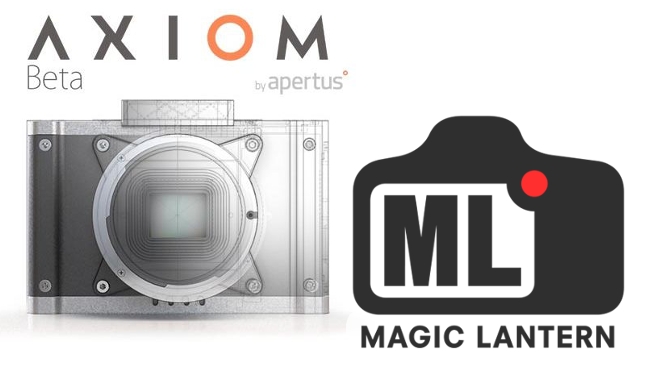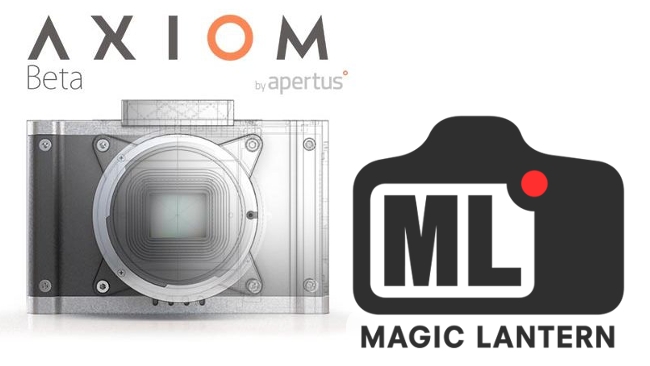

In what began as a show of mutual admiration on the Magic Lantern forum, the team responsible for unlocking the capabilitities of Canon DSLRs has joined the Axiom open source 4K camera project.
Sure, there is a growing crop of 4K cameras to choose from, but for those that want complete freedom to make their cameras their own, there's the Axiom camera project. The project, which has been brewing for two years, aims to release an 4K camera with a complete open source philosophy for both software and hardware, hopefully leading to a fully modular and customizable camera in the near future.
We've covered the Axiom project extensively; recently, RedShark ran an article on its Indiegogo campaign (which, as of this writing, has 11 days left to reach its goal). One of the principal architects of the Axiom project, Sebastian Pichelhofer, alerted us to a new partnership that may get those on the fence to hop over to Axiom.
Axiom gets Magic Lantern
In a rather stunning development, the team at Magic Lantern, which gained fame through its firmware add-on for Canon DSLRs that unlocked the true capabilities of these cameras, has joined forces with the Axiom project. (Here's a brief announcement on the Axiom Indiegogo page.) It began with an analysis of the sensors offered for Axiom Beta supporters, but will undoubtedly expand to other phases of testing and development.
This is big news for both followers of the Axiom project and Magic Lantern. The Axiom project gains from not only the technical expertise of the Magic Lantern team, but also through the credibility of the Magic Lantern brand, which is respected by many DSLR shooters. Magic Lantern benefits because, as we've hinted before, Canon may be quietly bowing out of the DSLR budget 4K race, which may diminish the relevance of ML's efforts on future Canon cameras. The Magic Lantern team, by linking up with Axiom, gives it another platform to work on, and one that readily shares it's open philosophy.
As I mentioned, there are currently only 11 days left in the Axiom Indiegogo campaign. It's a fixed funding campaign, so if news of Magic Lantern's involvement makes the Axiom a more attractive project, jump over to the project page and pledge your support.
Check out Pichelhofer's recent post about the Axiom Beta sensor tests from the Magic Lantern forum on Page Two!
Axiom Beta senosr test: Pichelhofer's response
If you want a very detailed explanation of the sensor test from Magic Lantern impresario 'A1ex', go to this post on the Magic Lantern Forum. Pichelhofer's response (which is quite illuminating) can be found below:
Many thanks for taking the time to measure all this, its indeed very interesting.
About row noise please check the application note from CMOSIS I emailed you (a1ex), they suggest applying a reference voltage to some additional sensor pins and report a significant improvement in row noise behavior.
About PLR:
I also think it can go beyond the officially listed 15 f-stops - I ran tests with +6 F-stops and while the footage was not without flaws in general it worked and definitely looked promising.
I noticed though that color saturation decreases with the amount of PLR highlight recovery and the fixed pattern noise is getting stronger in those areas. Both effects might be possible to compensate in internal image processing. Maybe we can measure/benchmark those settings as well in the future.
Here is a quick +6 stops test where I varied the lens aperture to measure latitude differences before turning on PLR: https://www.youtube.com/watch?v=jF68AJ14Uu4
PLR HDR vs HDRx:
As I understand it (I have not personally shot any HDRx footage on Red cameras) the differences are:
-) HDRx saves 2 exposure bracketed image streams and you can mix them together with different algorithms in post.
-) PLR HDR combines 2/3 (selectable) exposure brackets and mixes them together based on luminosity threshold on the sensor as the images are gathered already. The output is a single image stream - no post processing required to combine exposures.
-) with PLR highlights loose light sensitivity - shadows keep their light sensitivity - the curve can be tweaked in all aspects.
-) with PLR flickering can occur in highlights created by flickering light (AC tungsten, flickering CRT screens, magnetic ballast fluorescent tubes) as PLR reduces exposure time in highlights, but PLR actually does up to 3 exposure phases in one normal exposure time (not a single short one) so the effect might not be that visible -> will require more tests (I have not seen flickering in any PLR footage I shot yet - but I used PLR tweaking mostly with bright sunlight which will obviously not start to flicker :) )
About max FPS
The CMV12000 V2 can indeed go up to 300 FPS at full 4096x3072 resolution in 10 bit mode, in 12 bit mode this max FPS is reduced to 180 FPS according to official specs. By reducing the number of read rows (smaller window -> e.g. reading a 16x9 window from the 4:3 sensor) the max FPS will increase beyond the 300/180 FPS.
Other Sensors
Canon doesn't sell their sensors, Sony only sells to partners or large volume orders and they only sell a small selection of the sensors, not their latest cinema ones. There are only a few companies who sell large diameter sensors beside the mentioned Kodak/Truesense, Cmosis, Aptina that are OnSemi (VITA12/16/25 series) and dynamax imaging which all offer similar specs for similar prices.
The biggest factor for us though is that the sensor datasheet can be shared without an NDA and that only Cmosis and Truesense agreed to. It is essential that developers and the community have access to this documentation and we will not incorporate any image sensor that has no open documentation. After all these measurements as a1ex did them would have been pretty much impossible otherwise.
Tags: Business


Comments